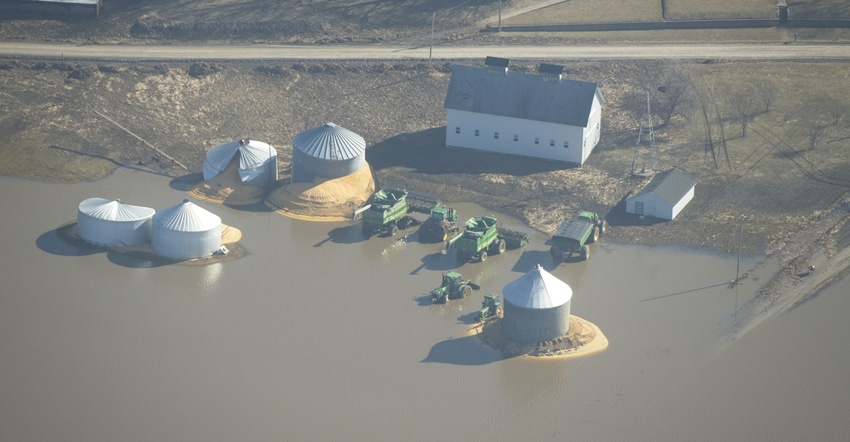Breakdown in Corps’ communication exasperated flood impact in aftermath of another record flood.

For 100 years, Leo Ettleman of Sidney, Iowa, and his family have farmed the Missouri River bottomland. In the last decade, he has faced two 100-year flood events.
Flooding has occurred along the Missouri River almost every year since 2007. “In 2008, we experienced tremendous damage due to seep water and blocked drainage. In 2010, the situation worsened, and come 2011, we had an all-out levee breach of the Missouri River just a half-mile from our family farm," Ettleman said. “Our land was devastated. It took nearly four years to clean up the mess.”
This year’s event will affect, at a minimum, three years of crops. The 2018 crop in the bins was destroyed, and the 2019 crop will not get planted. “If levees do not get repairs, we will be at risk in the future,” he told House Agriculture Committee members during a hearing June 20.
In the wake of this devastation, he said the 2019 event led to a “complete breakdown” in communication for those affected by the flood.
On March 6, the National Weather Service released its “greatly enhanced risk rating list” -- but northwest Iowa, northeast Nebraska, southeast South Dakota and the Platte River that runs through it were not on that enhanced list. “Seven days later, disastrous flooding hit that area,” Ettleman said. Poor or ineffective weather modeling left those in the wake of the bomb cyclone unprepared.
Adding to the pain, he said communication from the Army Corps of Engineers’ Omaha, Neb., district was nonexistent. “When we did finally get communication, it was too little too late,” Ettleman added.
In the aftermath, Sen. Joni Ernst (R., Iowa) called on the Corps to address shortcomings in its communications. In a response to Ernst, the Corps outlined its pledge to improve communication and provide regular updates to levee sponsors and those in harm’s way throughout the duration of flood season.
Infrastructure challenges
Ettleman testified that although waters are receding, the damage represents a war zone. Roads running east to west have been destroyed.
“Even when the water goes down, it could be weeks until we can return to our farms to begin the arduous task of cleaning and repairing,” he said.
Sections of Interstate 29 remain closed. “Traffic that should be coursing up and down Interstate 29 has been rerouted to county highways. These two-lane roads were not designed for safely handling such heavy traffic flows, resulting in spikes of traffic accidents and motorist injuries and fatalities,” he added.
With roads impassable in many locations and floodwaters slow to recede, Ettleman said nearly 85,000 bu. of his grain are still stranded. This includes 65,000 bu. of corn and 20,000 bu. of soybeans valued at nearly $450,000.
“Floodwater has impacted the first 12-14 in. of the pile. The moisture, along with warming summer temperatures, created the perfect scenario for rotting grain. So, as we sit on the sidelines, our grain supplies shrink, along with the much-needed income it represents,” he said.
Ruth Gerdes, president of Auburn Agency Crop Inc. in Auburn, Neb., noted that while it previously took 20 minutes to travel across the county, it now takes three hours due to areas inundated with water. “We’re still very much under siege,” she said.
Many operations owe money against the grain that was destroyed during this year's flood. Sadly, there are some that won’t recover, Ettleman testified.
The $19 billion disaster bill, which was signed by the President in June, includes an amendment by Sen. Chuck Grassley (R., Iowa) designed to provide relief to farmers who lost stored grain in recent floods. Estimates are that more than 800 on-farm storage bins located in eastern Nebraska and southwest Iowa burst open, spilling upwards of 10 million bu. of grain into standing floodwaters. The damaged grain losses delivered a blow to affected producers.
Unlike the Livestock Indemnity Program, prevented planting disaster relief and farmland restoration and watershed recovery grants, the U.S. Department of Agriculture did not have a disaster relief program on the books for stored grain damaged by natural disaster. Grassley’s amendment helped bridge the coverage gap.
Flood prioritization
Also in response, Ernst and Midwest senators have introduced the Missouri River Flood Control Prioritization Act, which would make flood control the number-one priority in the Corps’ master manual and would eliminate “fish and wildlife” as an authorized purpose. It requires the Corps to make those updates to the manual within 90 days of the bill becoming law. The master manual, which dictates the Corps’ management of the Missouri River, includes eight congressionally authorized purposes: flood control, river navigation, hydroelectric power, irrigation, water supply, water quality, recreation and fish and wildlife.
“The recent catastrophic flooding across farm country has been well publicized, but what’s largely ignored is the mismanagement of our inland waterways and the lack of flood control prioritization” Ettleman testified. “Close to my home, I’ve seen changes made to the management and flow of the Missouri River. Since then, flooding events have become more frequent, severe and costly.”
Another bill, the Army Corps of Engineers Flood Control Civilian Advisory Council Act, would create a new civilian advisory council comprised of two members from each state along the Missouri River to play a part in advising the Corps on river management. The bill mandates that representatives from the agricultural industry must be included on the council.
About the Author(s)
You May Also Like





